
Optimizing the precision blending of nutraceuticals
Mike Edwards
Features GEMCO Casey Muench (right) & GEMCO Equipment.
Casey Muench (right) & GEMCO Equipment. Tumble blender technology enhances the speed and homogeneous blending of nutraceutical components and powders to substantiate label claims and clinical trials.
Nutraceuticals can encompass a wide variety of health-related products including vitamins, supplements, mineral blends, and even various foods like energy bars. Many of these formulations involve the fine blending of as many as 40-50 components, including powders and trace elements.
While nutraceuticals are not strictly regulated like pharmaceuticals, the products still must substantiate any label claims, and a number are actually tested in clinical studies like medicines.
“Whenever a nutraceutical makes a label claim, like specific RDA or FDA allowances, vitamin percentages, or active components, it has to meet those criteria,” says George Paffendorf, director of operations at Advanced Powder Solutions (APS), a company that specializes in developing and optimizing the blending of powders for various industries. APS is the in-house testing/engineering arm of GEMCO, a manufacturer of tumble blending and vacuum tumble drying equipment with technical, nutraceutical expertise.
As an example, APS helped to blend the various components for an energy bar (nuts, raisins, dried banana, flaked coconut etc.), which were calculated to meet a minimum daily requirement for vitamins and minerals. “The blends had to be precise enough to
meet the label’s nutritional claims,” says Paffendorf.
Furthermore, nutraceutical products must not only avoid doing harm, but also increasingly substantiate any claims or benefits. “The industry often wants to show the benefit of certain nutraceutical components in clinical studies, which have to be controlled just like pharmaceuticals,” adds Paffendorf.
One industry challenge is that the blending of solid ingredients is easier and more uniform if the ingredients are approximately the same size. However, it is more difficult to create precise blends with trace ingredients (<1%) that are vastly dissimilar in size and density. In some cases, this might require doing multiple key blends in a time-consuming and costly process.
Fortunately, with tumble blending equipment that is engineered to meet the requirements of the application, the process can be simplified to rapidly produce a more precise, homogenous blend containing all necessary components and trace elements in the specified amounts. Such blending can not only eliminate the need for key blends, but also produce a better distribution of active ingredients.
The Limitations of Traditional Mixing Equipment
Traditional equipment such as plow, ribbon, and paddle mixers, which use blades or paddles to push material, are limited to moving the material within the confines of their active area. The mechanics force the material bed outward, leaving dead spots inside the vessel where material moves more slowly or remains stationary. A stationary port at the bottom of such machines further isolates the material.
Another issue lies in the positioning of the intensifier bars, which should ideally be located in the mixing zone, where every particle passes through. Many times, however, traditional mixers position intensifier bars in dead zones, resulting in material not being fluidized properly and active ingredients getting incorporated throughout the batch.
Traditional mixers also waste expensive additives. Because additives initially contact only a very small portion of material in the vessel, they get quickly absorbed into the material bed, so more additives are usually needed to achieve the desired mix concentration, which increases cost.
The Benefits of Tumble Blending and Vacuum Tumble Drying
To address the deficiencies of traditional mixers, a growing number of nutraceutical manufacturers utilize tumble blending. As a low-impact processing technique for handling sensitive or abrasive solids, tumble blending is commonly used to create precise nutraceutical blends that contain trace ingredients (<1%) that are vastly dissimilar in size and density.
In contrast to traditional mixing, to eliminate dead spots, tumble blenders apply even turbulence in all corners of the mix through a combination of macro and micro blending. This can eliminate the need for key blends and produce a better distribution of active ingredients.
Macro blending is achieved by rotating the shaped vessel, allowing the material bed to fall away from the vessel’s walls. Tumble blender vessel shapes are engineered to create a repeatable pattern in which the entire bulk material moves to form a homogenous mixture. The blender moves at a precise speed, with the vessel wall at a precise angle, so that the material cascades over itself. There is no additional force from paddles, plows, or spiral ribbons – just gravity.
While this occurs, micro mixing (if needed) simultaneously proceeds via agitator blades located in the mixing zone center of the vessel, where fine processing in the material transpires. This allows for a gentle repeatable pattern that maintains a superior blending design while preserving the product’s physical characteristics. Together, the macro and micro mixing evenly expose each particle to six times more active blending per revolution than traditional mixers.
As an example, when APS worked with a large nutraceutical manufacturer in Nevada with an approximately 40 component blend, the company was not utilizing an agitator and had a laborious, overly complex blend process.
“To make about 1,000 kilos of product a few times a year involved 6 or 7 separate steps with key blends that had to be lab tested after each step to reach a final blend with the necessary traceability, materials and active components,” says Paffendorf.
Through onsite analysis of the manufacturer’s process, including examination of the physical characteristics of the powders used, APS determined that all of the components could be mixed in one step. This involved both macro and micro mixing using a GEMCO tumble blender with an agitator to complete the process in a fraction of the time without key blends or excessive lab testing.
“If you turn on the tumble blender agitator, it can fluidize the entire bed of material and you get great product distribution because it helps to spread it out through the micro-mixing zone.”
“According to the customer, the new process using a tumble blender with an agitator saves them about $875,000 a year by eliminating the need for key blends and all the intermediate testing,” says Paffendorf.
 Douglas Van Pelt, a former part owner of a nutraceutical company, has also benefited from tumble blending. Van Pelt, who is now Senior Director of Operations at Sigmapharm Laboratories LLC, a privately held specialty pharmaceutical company based in Bensalem, PA that develops, manufactures and markets generic and branded products, had successfully used tumble blenders at a previous company and trusted their capabilities.
Douglas Van Pelt, a former part owner of a nutraceutical company, has also benefited from tumble blending. Van Pelt, who is now Senior Director of Operations at Sigmapharm Laboratories LLC, a privately held specialty pharmaceutical company based in Bensalem, PA that develops, manufactures and markets generic and branded products, had successfully used tumble blenders at a previous company and trusted their capabilities.
“At my previous employer, I made a product that had a narrow therapeutic range using a 30 cubic foot tumble blender by GEMCO,” says Van Pelt, who notes that blend uniformity specification was a very stringent 95.0% to 105.0%, not a typical 90.0% to 110.0%. “The potency was 0.125 milligrams inside a 125-milligram tablet, and we were able to achieve blend uniformity in 15 minutes, with good repeatable results every time.”
According to Van Pelt, Sigmapharm has effectively implemented a 30 cubic foot V blender and a one cubic foot slant cone blender from the tumble blender manufacturer.
“Over decades, GEMCO has essentially perfected tumble blending,” says Van Pelt. “They engineered the precise angles and speed of revolution needed to achieve proper blending inside the vessel and can adapt this based on product requirements.”
With the preciseness of the technology, a V-shape tumble blender is capable of achieving a standard deviation of less than 2%, and a slant cone configuration can achieve a standard deviation as low as 0.33%.
In the nutraceutical field, loading can be accomplished via drum loading. This includes a unique dust-free, Gemcomatic loading option, where the tumble blender rotates until the drum inverts and the discharge valve opens, allowing the contents to flow into the blender. The valve then shuts automatically and the emptied drum returns to the loading position. The latest version allows for a pre-programmed discharge sequence.
Older systems may still utilize kitted materials, with various components pre-weighted in bags on a pallet that must be put into nutraceutical batches.
In addition to tumble blending, a growing number of nutraceutical manufacturers are finding that vacuum tumble drying equipment offers significant advantages as well.
Wet nutraceuticals can be a problem, particularly when sugars or starches combine with water and conglomerate, making the product sticky and particle flow difficult.
As a solution, advanced vacuum tumble drying equipment can resolve such issues.
While typical tray drying relies solely on heat, vacuum tumble drying equipment like GEMCO’s utilize gas purging in addition to heat application as the materials rotate inside the vessel, which can speed drying and reduce cost.
For nutraceutical manufacturers that have sought to ensure product quality through the fine blending of many components, but were unsatisfied with traditional methods, tumble blending will help to optimize the process. With greater process control, manufacturers will even be able to significantly reduce blending steps and cost, while substantiating label claims and clinical trials.
This article was contributed by GEMCO of Middlesex, N.J.
Print this page